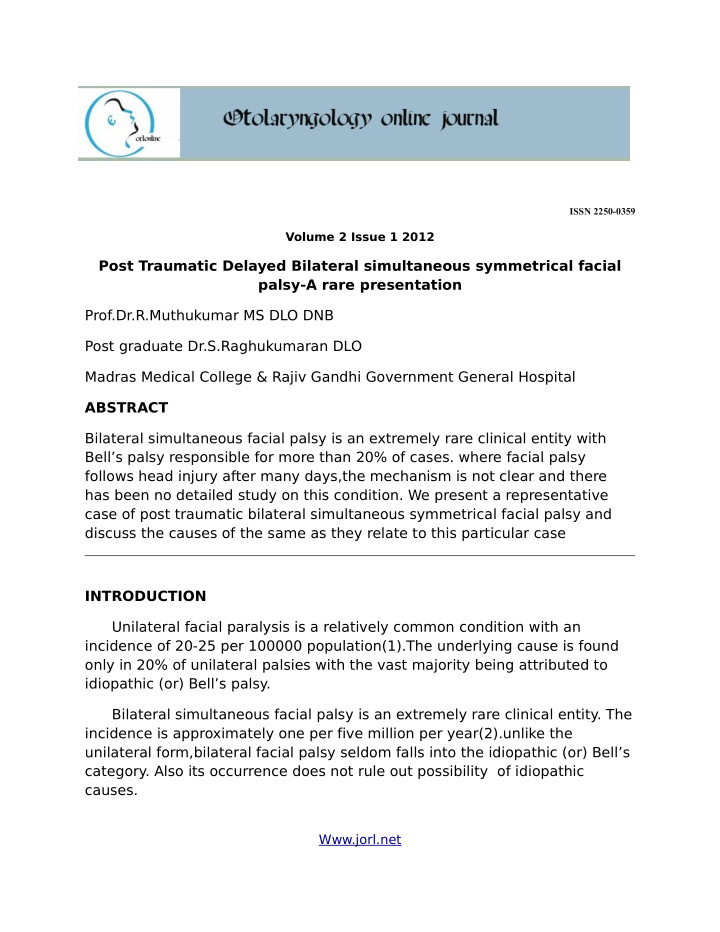



ISSN 2250-0359 Volume 2 Issue 1 2012 Post Traumatic Delayed Bilateral simultaneous symmetrical facial palsy-A rare presentation Prof.Dr.R.Muthukumar MS DLO DNB Post graduate Dr.S.Raghukumaran DLO Madras Medical College & Rajiv Gandhi Government General Hospital ABSTRACT Bilateral simultaneous facial palsy is an extremely rare clinical entity with Bell’s palsy responsible for more than 20% of cases. where facial palsy follows head injury after many days,the mechanism is not clear and there has been no detailed study on this condition. We present a representative case of post traumatic bilateral simultaneous symmetrical facial palsy and discuss the causes of the same as they relate to this particular case INTRODUCTION Unilateral facial paralysis is a relatively common condition with an incidence of 20-25 per 100000 population(1).The underlying cause is found only in 20% of unilateral palsies with the vast majority being attributed to idiopathic (or) Bell’s palsy. Bilateral simultaneous facial palsy is an extremely rare clinical entity. The incidence is approximately one per five million per year(2).unlike the unilateral form,bilateral facial palsy seldom falls into the idiopathic (or) Bell’s category. Also its occurrence does not rule out possibility of idiopathic causes. Www.jorl.net
Fig 1 Fig 2 CASE REPORT A 23 year old male with no previous aural symptoms presented to ENT OPD with inability to close both eyes,blow the cheek and stasis of food in vestibule of mouth past one week duration. He had bilateral facial palsy(House 4).On carefully eliciting the history he revealed that two weeks before had a road traffic accident and presented to casualty where past records showed no facial weakness at time of presentation. Left side 2 nd ,3 rd and 4 th rib fracture ,left ear bleed, left zygoma and left lateral wall of orbit fracture are his other physical injuries noted. ICD done on left side and removed on 3 rd day. Patient managed conservatively and discharged. FIG 3 Www.jorl.net
Other cranial nerves III-VI and IX-XII and fundoscopy was normal. On otoscopic examination Right TM-retracted and left TM-traumatic CP in anteroinferior quadrant. PTA done showed bilateral normal hearing sensitivity with low threshold for high frequencies. An urgent computed tomography(CT) scan of temporal bone and brain was normal. Electrical studies done. Bilateral flickering movements for normal stimulus. Patient responded to supra threshold stimulus at stylomastoid foramen on both sides.Presumptive diagnosis of Bilateral simultaneous symmetrical facial palsy was made. FIG 4 FIG 5 Pure tone audiometry Www.jorl.net
CT TEMPORAL BONE-NORMAL He was commenced on intravenous methyl prednisolone 1gm 3 days and methyl cobalamine 2cc IM 3days then started on oral steroids and dose tapered. His eyes was closed with a patch and ciprofloxacin eye drops was applied.He recovered rapidly and on day 8 electrical studies repeated showed brisk response for normal threshold. Www.jorl.net
Fig 6 DAY 1 DAY 3 DAY 5 DAY 7 DISCUSSION The facial nerve is the motor cranial nerve which is most commonly affected in closed head injuries. In facial palsy which immediately follows a head injury the mechanism is obvious but it is not clear when facial palsy follows the head injury after many days. Www.jorl.net
ONSET : The delay in onset of facial palsy after head injury varied from 2-21 days(3).The cases of conduction block had a delayed onset of 7-9 days. CAUSES: According to Prof May, in his study on facial palsy among 3650 pt only 2%[80] showed bilateral facial palsy and among 80,23 pt had traumatic etiology(Iatrogenic-5 & accidental-18).Other causes are Bell’s palsy,facial hyperkinesia,neoplasm,CNS lesions,infection and others(9). CLINICAL PROGRESS : In cases with a conduction block clinical recovery of facial weakness started by about 5 th day and complete by 36 th day. In conduction block,recovery of facial movements was complete and there were no sequelae In the facial canal,the area occupied by the facial nerve is only 30- 50% of the cross-sectional area of the canal(7).the remainder of the facial canal is occupied by blood vessels with connective tissues loosely arranged around it. Delayed palsy is possibly the result of bleeding into the facial canal.Increasing size of hematoma in the limited non-expanding bony tube could press on the facial nerve and ultimately cut off its blood supply causing ischemic damage to the nerve(8).If the pressure were mild,there would be only a neuropraxia or conduction block due to segmental demyelination.If the damage were more severe there would be axonal damage with denervation due to a sudden shearing force The nerve could be compressed by its swelling within its fibrous sheath or epineurium and this swelling may be a delayed response to trauma to the nerve itself or secondary to damage to its surrounding vasculature causing oedema of facial canal which was non-bacterial which could be also likely cause of delayed facial palsy. Www.jorl.net
REFERENCES 1.T.PRICE,bilateral simultaneous facial palsy. The journal of otology and laryngology January 2002 vol 116 pp 46-48 2.HARTLEY C,MENDELOW AD. Post traumatic Bilateral facial palsy. Journal of Otolayngology 1993,107:730-1 3.SHERWIN PJ,THONG NC,Bilateral Facial Palsy,Acase study and literature review. Journal of Otolayngology1987;16:28-33 4.K.PUVANENDRAN,M.VITHARANA AND P.K.WONG delayed facial palsy after head injury Journal of neurology,neurosurgery and psychiatry 1977 40 342-350 5.BRIGGS.M AND POTTERJ.M(1971) Prevention of Delayed Traumatic Facial Palsy,British Medical Journal,4,464-465. 6.POTTER J.M AND BRAAKMAN.R(1976) in Handbook of Clinical neurology 7.POTTER J.M(1964).Facial Palsy following head Injury,Journal Of Laryngology.78,645-657 8.KRISTENSEN H.F(1968) Discussion on Facial Paralysis.Journal of Laryngology,82,665-666 9.MAY’S Text Book of Facial Nerve Www.jorl.net
Recommend
More recommend